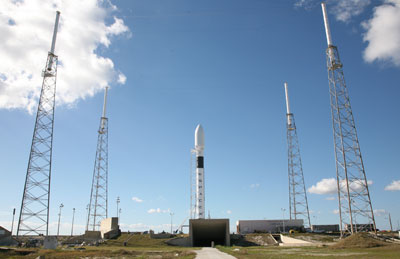The view from Austin on commercial spaceby Jonathan Coopersmith
|
| If the conference had been held in Houston, the negative aspects of the Obama Administration’s proposed shift of NASA priorities would probably have been emphasized. But the conference was held in Austin, where concern was less short-term than medium- and long-term. |
A sense of optimism—a feeling that this next decade will see a major expansion in space exploration and development—pervaded the speakers and audience. One reason was the growing presence of actors and ideas from outside aerospace, especially the fast-moving Internet community. While computer game entrepreneur and self-financed astronaut Richard Garriott and Google’s space projects manager Tiffany Montague were the most visible examples, as important was the presence of Esther Dyson, a long-time Internet entrepreneur and analyst. Significantly, Garriott and Dyson are members of NASA’s newly revised Advisory Council, implying that the Obama Administration has an image of a future NASA that is significantly different from the NASA of the last few decades. All three promoted an Internet ethos for space: experimenting, trying, failing, doing, and learning with much greater movement and cross-fertilization of people and ideas than now.
Another reason for optimism was the expectation that new generations of rocket and space technology would drastically drop the cost and effort of space operations. Whether these expectations will move from PowerPoint projections to reality is the key question. Speakers emphasized the importance of private and government initiatives and of cooperation between those sectors.
If the conference had been held in Houston, the negative aspects of the Obama Administration’s proposed shift of NASA priorities would probably have been emphasized. But the conference was held in Austin, where concern was less short-term than medium- and long-term. Indeed, the organizer, Richard J. Phillips, president of Phillips & Company, stated that the purpose of the meeting was to switch from a mission-centric to an application-centric perspective of space exploration and development, especially in communications, environmental monitoring, energy, and national security.
What that seemed to mean was expanding and promoting opportunities for profiting from space. Worldwide, the space market, according to Futron and the Space Foundation, is approximately $260 billion, mostly from governments, launch services, and communications satellites. A small but growing segment was the increasingly wide range of applications enabled by space systems. Not all would obviously be classified as space businesses. James Hollopeter of GIT Satellite Communications highlighted the expanding number of GPS- and transponder-based applications such as tracking the location of materials on a construction site.
A major concern in informal discussions was that the reaction to the Obama Administration’s proposed cancellation of Constellation to focus on commercial launch systems and human exploration beyond the Moon was polarizing and politicizing the space community. There was real fear of a fractionated and internally alienated community.
Should the concern be about the jobs lost, a short-term issue affecting the fired people and the local economy (and politicians), or the potential loss of expertise with human spaceflight, which could have significant, negative consequences for the economy? As Mary Lynne Dittmar, who raised the latter perspective, noted, one challenge was to figure out what expertise was needed and by whom. Esther Dyson, while sympathizing with the JSC workers, emphasized that NASA was not established as a jobs program but to develop technology and explore.
| Increasing access to space—making it affordable—will not be an unalloyed good. |
The issue of governance, or its lack, lingered through several talks. At the national level, speakers mentioned the lack of coordination within the US government and between industry and government (universities were not considered sufficiently important players, which is certainly true financially). The problems—neither new nor unique to space—include lack of overarching policies, inadequate coordination (especially by resisters), slow bureaucracy, and short-term thinking.
Internationally, the growing number of spacefaring nations, satellites, and orbital debris is creating an environment that is increasing competitive, contested, and congested. And then there is the increasing number of potentially hostile actors, a growing concern as the United States military is asymmetrically dependent on space systems (increasingly commercial) compared with potential adversaries.
A prevalent theme was the need to reduce the cost of reaching orbit, operating in space, and building equipment. New business models, based on developing the scale and increasing the scope of access to space, will be as important as the actual technologies. The magic goal was reducing costs by one or two orders of magnitude or, as Richard Garriott succinctly stated, reducing the cost of launching an astronaut to under $1 million.
Increasing access to space—making it affordable—will not be an unalloyed good. Hal Hegemeier, fulfilling the National Space Security Office’s role of raising thoughtful (if disquieting) questions, asked what the consequences of more systems in space, including those of nonfriendly actors, could be. He did not have the answer, but that is the right sort of question to ask.
